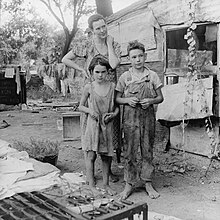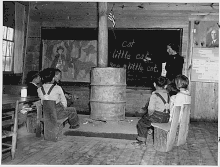Federal Writers' Project – Life Histories/2021/Summer/105/Section 10/Dick Striker
Overview
[edit | edit source]Dick Striker was a Caucasian American male born around 1875 in Goldsboro, North Carolina. He was interviewed by William Forster on September 12, 1938, at the reported age of 63.
Biography
[edit | edit source]Federal Writers' Project – Life Histories/2021/Summer/105/Section 10/Dick Striker | |
|---|---|
| Occupation | Farmer |
| Spouse(s) | Mary (Smith-Jackson) Striker |
Personal Life
[edit | edit source]Dick Striker was born and raised on a farm near Goldsboro and Newton Grove, North Carolina. At the age of twenty, Striker married and had four children. Unfortunately, three of those children, and his first wife died at a young age. Six months after his fist wife’s death, Striker married a widow named Mary (Smith) Jackson. Mary Smith had her first marriage at the age of fifteen and had three children, two of whom died at a young age. Dick and Mary Striker had one daughter together, who was born a year after they married. In 1928, Dick’s brother, John Striker, died, leaving two small boys, as John’s wife had also passed away shortly before. As a result, Dick and Mary Striker adopted the children.[1]
Livelihood
[edit | edit source]As a farmer in the early-twentieth century, Striker struggled immensely to live and support his family because of the extreme poverty farmers faced. Every year Striker maintained at least 15 acres of farmland tilling cotton, corn, and tobacco, among other products. For this work, Striker’s annual wage was a meager fifty dollars (about eight hundred dollars today), plus ownership of a small, rustic house and garden. Thus, Striker had little to no discretionary income to raise and support, which had a major impact as the family struggled to get food, clothing, or shelter. In fact, Striker’s adopted sons had so little clothing that Reverend Anthony Wilkins, a pastor at a nearby church and Striker’s nearest neighbor, considered requesting welfare workers to “get the boys some clothes”. Striker’s house was very poorly maintained. Striker himself stated, “‘I don’t suppose the owner could get anyone to live here except me.’”[2] This issue of poverty did not only affect Dick Striker, but all farmers in the Great Depression.
Social Issues
[edit | edit source]
Employment/Poverty
[edit | edit source]The problem began in World War One. During the war farmers–especially those from Western countries, “substantially increased their productive capacity, augmenting inputs and adopting several innovations, most notably mechanical ones.”[3] However, demand stagnated as the consumption of agricultural products remained constant (price and income inelasticity) despite greater supply. In addition, the population was increasing much more slowly than before the war. The excess production either converted to stocks, was financed with short-term loans, or, most significantly, caused prices of agricultural products to decline steeply.[4] Agriculture price declines had a significant influence on the rest of the economy, as they lowered overall demand. Prices fell further, lowering investments and diminishing exporters' purchasing power, compelling them to quit the gold standard.[5] As a result, the Great Depression ensued, and farmers were highly vulnerable to any additional decrease in prices, even a relatively mild one.[6]

Education
[edit | edit source]One of the major issues that stemmed from these economic disparities in rural areas was education. Education in rural America during the 1930s was virtually non-existent, for a few reasons. Villages and rural areas were difficult to access, school facilities were insufficient, and student performance was low when compared to other schools.[7] These conditions were exacerbated during the Great Depression. During the Great Depression, the value of farm land and agricultural products fell drastically. This directly impacted the education system as taxes that were drawn on those sectors and used to support schools fell.[8] However, it also had a large indirect effect on education. In the 1930s, children whose families farmed for a living–as did most North Carolinians–had a harder difficulty attending school than children who lived in towns. These rural youngsters may be required to miss school for planting, hoeing, and harvest. In order to live, most families need all members to work.[9] In the case of Dick Striker, this was picking cotton. For more than three weeks, Striker kept his kids from the consolidated school at Newton Grove, and forced them to pick cotton.[10]
References
[edit | edit source]- ↑ Interview, Forster, William O. on Dick Striker, September 12, 1938, Folder 397, Federal Writing Project Papers, Southern Historical Collection, UNC Chapel Hill.
- ↑ Forster, 4
- ↑ Giovanni Federico, “Not guilty? Agriculture in the 1920s and the Great Depression” Journal of Economic History 65, no. 4 (2005) 949
- ↑ Jakob Madsen, “Agricultural crises and the international transmission of the Great Depression” Journal of Economic History 61, no. 2 (2001) 329
- ↑ Barry Eichengreen, “Golden Fetters. The Gold Standard and the Great Depression, 1919-1939.” The Economic History Review 47, no. 1 (1994) 407
- ↑ Federico, 950
- ↑ Michael Gardiner, “Education in Rural Areas” Issues in Education Policy no. 4 (2008)
- ↑ Claudia Reinhardt, Bill Ganzel, “Going to School in Rural America during the 1930s”, Ganzel Group, 2003. https://livinghistoryfarm.org/farminginthe30s/life_21.html.
- ↑ Anita Davis, “Public Schools in North Carolina in the Great Depression | NCpedia”, Tar Heel Junior Historian, 2010. https://www.ncpedia.org/public-schools-great-depression.
- ↑ Forster, 7
Bibliography
[edit | edit source]Aldcroft, Derek H., and Barry Eichengreen. 1994. “Golden Fetters. The Gold Standard and the Great Depression, 1919-1939.” The Economic History Review 47 (1). https://doi.org/10.2307/2598244.
Davis, Anita. “Public Schools in North Carolina in the Great Depression | NCpedia”. Tar Heel Junior Historian, 2010. https://www.ncpedia.org/public-schools-great-depression.
Federico, Giovanni. 2005. “Not Guilty? Agriculture in the 1920s and the Great Depression.” Journal of Economic History 65 (4). https://doi.org/10.1017/S0022050705000367.
Gardiner, Michael. “Education in Rural Areas”, Issues in Education Policy no. 4 (2008): 1-33
Interview, Forster, William O. on Dick Striker, September 12, 1938, Folder 397,
Federal Writing Project Papers, Southern Historical Collection, UNC Chapel Hill.
Madsen, J. B. 2001. “Agricultural Crises and the International Transmission of the Great Depression.” Journal of Economic History 61 (2). https://doi.org/10.1017/S0022050701028030.
Reinhardt Claudia, Ganzel Bill, “Going to School in Rural America during the 1930s”. LivingHistoryFarm. Ganzel Group, 2003. https://livinghistoryfarm.org/farminginthe30s/life_21.html.=
